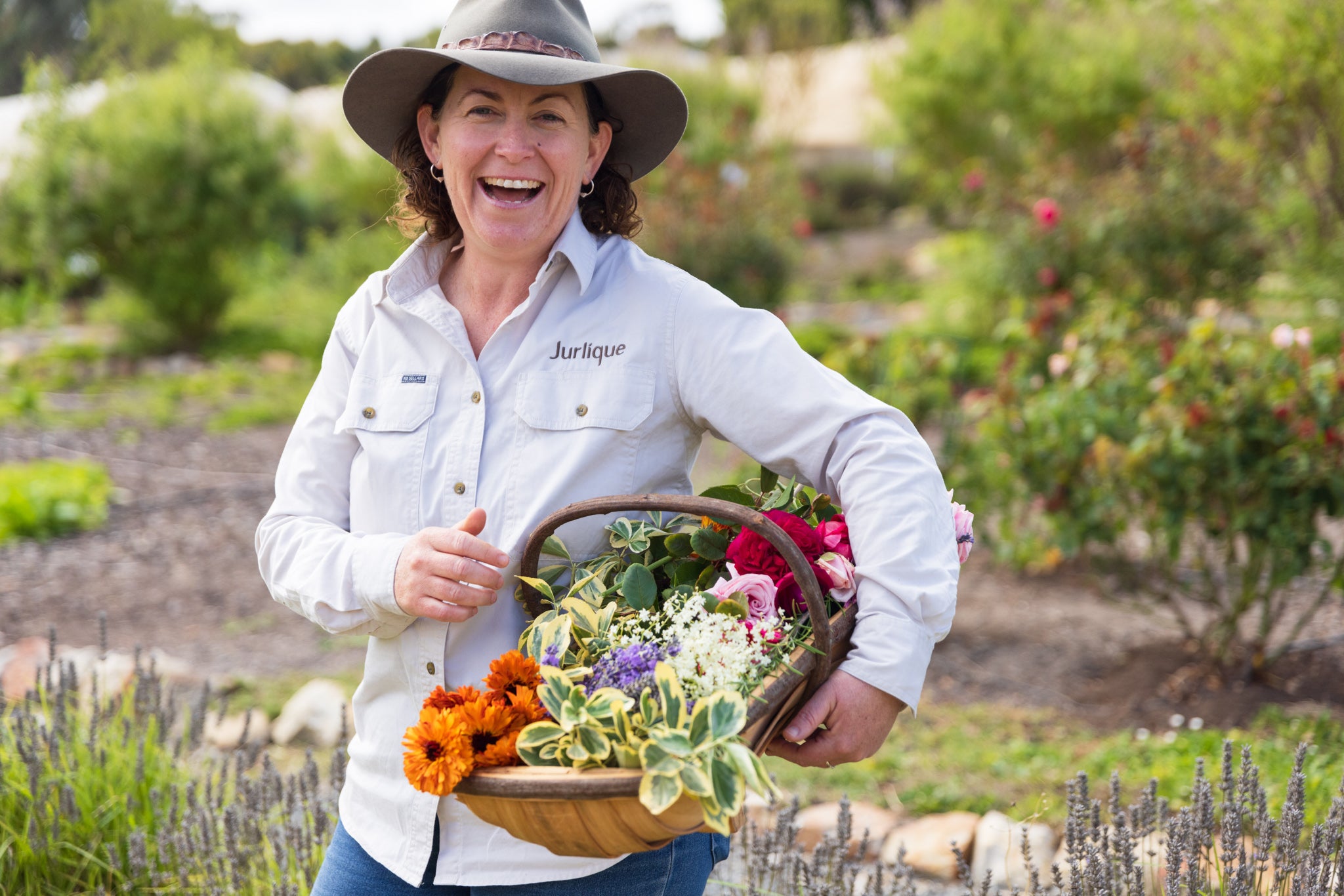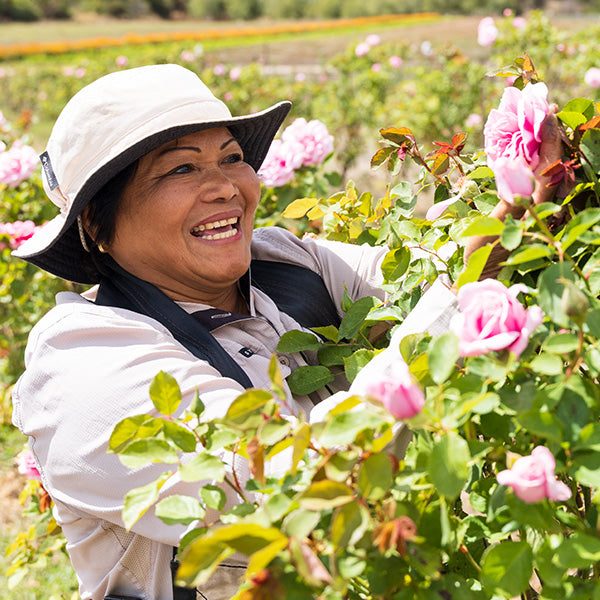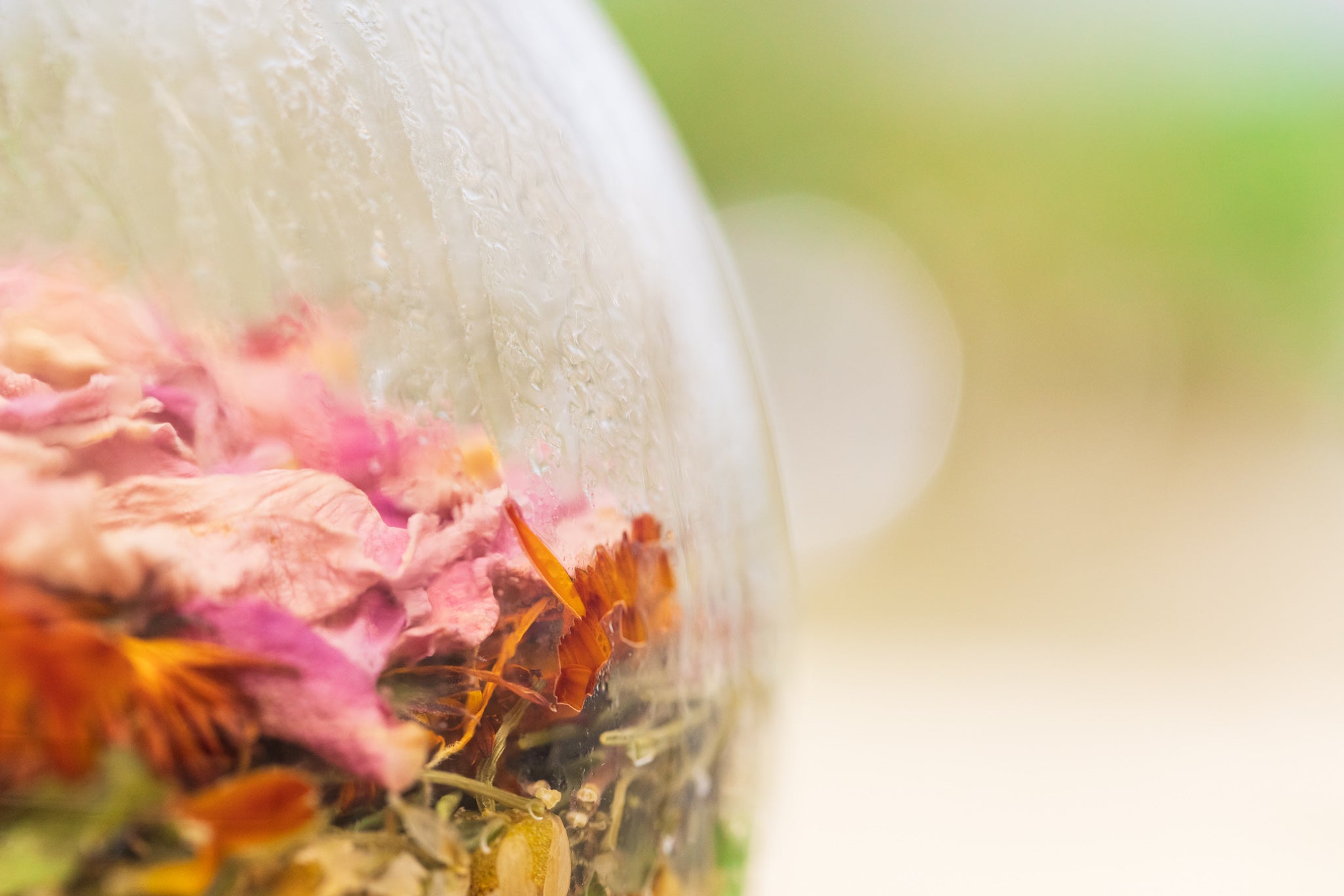At Jurlique, we’ve been planting, growing and harvesting our botanicals on our certified biodynamic* farm in South Australia’s Adelaide Hills since 1985. It’s all done by hand – from the biodynamic* preparations, to the weeding, planting and harvesting, right through to the Bio-Intrinsic™ process that creates the powerful extracts that go into our products.
We may be biased but the people at our farm are nothing short of incredible. It’s a small, close-knit group working together to care for our land, following our biodynamic* practices and ensuring that the botanicals that make it into our products are the best they can possibly be.
One individual that works on our farm (and has done since 2005) is Pam Cherry, somewhat of a superwoman to us at Jurlique. To give her one title would do her a disservice as she seems to be involved in most aspects of our farm – from beekeeping and biodynamic* preparations, to Bio-Intrinsic™ processes and looking after our Spilanthes and polyhouses. We sat down with Pam to find out more.

What does an average week on the Jurlique Farm look like to you?
My week varies throughout winter, summer and spring. In January we’ll be thinking about what we need to plant in Autumn. We normally get a schedule for the year that might say we don’t need Viola Tricolors, or we need a tonne of something else. Then I plan when to start seeding and I’ll start collecting seeds the following spring.
And then there’s always ashing [part of the Bio-Intrinsic™ process]. I’ll ash perhaps two or three batches in a week. I wash it, dry it, burn it, ash it and then try and turn it around in a week. I wash them in the washing machine – just on a rinse spin - and then it goes on the drying racks to be dried. Depending on the herb it can take 2-3 days or 4-5 days. Once dried, it goes into the combustion stove and gets burnt, then onto the stovetop where it’s ashed, which breaks down all the particles. I’m literally with a pan, stirring it over a stove with a spatula. Ashing can take all day sometimes, or two days.
I also do propagation [growing new plants from a variety of sources: seeds, cuttings, and other plant parts]. We’ll plant a lot of the cool weather plants in Autumn such as Viola Tricolor, Bellis and Chamomile – they’ll go in the ground probably April. We’ve got to have them in a decent size as the farm crew will be preparing beds and getting them ready for planting.

How many of you will plant the seeds?
There’s a team of about three. They could plant two rows in a session, depending on how they come. If they get them in little pots, they’ve got to take them out, soak them in sea salt, plant them and then pour sea salt over them and plant it, so that’s a good session. It normally takes two and a half hours to do two rows, they work really quickly.
You’re our go-to for all things biodynamic* (in fact, you’re a bit of a guru). Can you tell us what goes into biodynamic* farming?
When we make up our compost, we always put in biodynamic* preps. Those preps go from 502 to 507 - we put in Chamomile, Yarrow, Oak Bark, Nettle, Dandelion and Valerian is sprinkled over the top of the compost. I make little balls that are made up from various parts of the property – clay, soil, compost. You put a hole in the centre of the ball and then you put a tiny amount of the prep in, close it up and those balls are put in a particular order into the compost. They go into the ground for six months, in either summer or winter, before we dig them up.
And then there are the biodynamic* sprays - Horn Manure (prep 500) and Horn Silica (prep 501) – which we do over summer. They’re the two preps we do twice a year to keep our biodynamic* status - you can’t do it if the ground is dry though, so you have to pick the right time. The 500 is sprayed into the ground and the silica is for the atmosphere, it attracts light and warmth. Whatever’s out there is radiated into the farm, it helps strengthen the plants.
What other biodynamic* practices do you follow on the farm?
I’m constantly doing checks to see what’s being eaten by mites or aphids. In that instance we’d determine how much of a threat it is, whether it’s going to ruin anything – for example, aphids on a Rose can damage the petals. Biodynamically you don’t want to react too hard but manage it gently. You don’t eradicate everything in organic and biodynamic* farming, rather you control, and you accept that there’s always going to be something out there. You’ve got to have the good and the bad, if it’s a perfect farm that means they’ve heavily bombed it with nasty stuff. Hopefully we get good numbers of good bugs, which the farm attracts – ladybirds, lacewings and hover flies – and they’ll come in and eat the aphids.

Do you notice a difference in the plants when they’re grown biodynamically?
I think the plants are better, they’re usually stronger. Some tests have been done with Calendula or Chamomile where we had organic farming, general farming, biodynamics*. They tested the flowers from all those different ways of growing them and the biodynamic* way was much more potent, our plant specialist proved that. In biodynamics*, everything is centred on working the soil, and as long as you’ve got everything working down there, whatever you plant will get the benefit.
It's safe to say Pam’s a busy woman but she wouldn’t have it any other way. In fact, she says the thing she loves about her job most is “being at the farm. It’s like being home in your own garden, I like to potter. It’s not work to me.
How does she keep track of it all? It’s all in her head, she says. See – superwoman.
*Certified biodynamic by the National Association for Sustainable Agriculture, Australia. Jurlique’s products and farm are not certified of affiliated with Demeter® USA or Demeter International.







